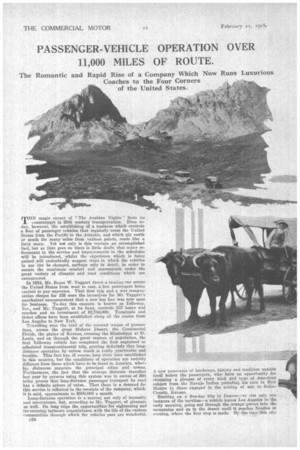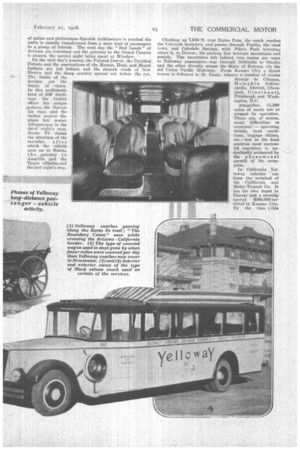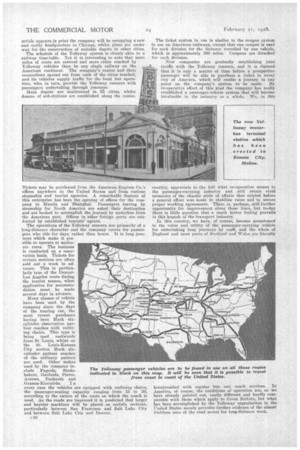PASSENGER-VEHICLE OPERATION OVER 11,000 MILES OF ROUTE.
Page 60

Page 61

Page 62

If you've noticed an error in this article please click here to report it so we can fix it.
The Romantic and Rapid Rise of a Company Which Now Runs Luxurious Coaches to the Four Corners of the United States.
TRV1 magic carpet of "The Arabian Nights" finds its counterpart in 20th century transportation. Even today, however, the establishing of a business which controls a fleet of passenger vehicles that regularly cross the United States from the Pacific to the Atlantic, and which ply north or south for many miles from various points, reads like a fairy story. Yet not only is this yen vure an• accomplished fact, hut as time goes on there is little doubt that ninny refinements in the service and improvements in the schedules will be introduced, whilst the ekperience which is being gained will undoubtedly suggest ways in which the vehicles in use can be changed, perhaps only in detail, in order to ensure the maximum comfort and convenienZe under the great variety of climatic and road conditions which are encountered.
In 1924, Mr. Roger W. Taggart drove a touring car across the United States from west to east, a few passengers being carried to pay expenses. That first trip and a war compensation cheque for £38 were the incentives for Mr. Taggart's nonchalant announcement that a new bus line was now open for business. Today this concern is known as Yelloway, Inc., and Mr. Taggart, at its head, controls 237 buses and coaches and an investment of $2,750,000. Terminals and ticket offices have been established along all the routes from Los Angeles to New York.
Travelling over the trail of the covered wagon of pioneer days, across the great Mohave Desert, the Continental Divide, the plains•of Kansas, crossing the Mississippi at St. Louis, and on through the great centres of population, the first Yelloway vehicle has completed the first organized or scheduled transcontinental trip, proving definitely that longdistance operation by saloon coach is really practicable and feasible. This fact has, Of course, long since been established in this country, but the conditions of operation are entirely different from those which have to be faced in America, where big distances separate the principal cities and towns. Furthermore, the fact that the average distance travelled last year by persons using this system was in excess of 800 miles proves that long-distance passenger transport by road has a definite sphere of value. That there is a demand for this service LS reflected in the receipts of the company, which. it is said, spproximate to $500,000 a month.
Long-distance operation is a waiter; not only of necessity and convenience, but, according to Mr. Taggart, of pleasure as well. On long trips the opportunities for sightseeing and for securing intimate acquaintance with the life of the Various is-immunities through which the vehicles pass are wonderful.
c38
A new panorama of landscape, history and tradition unfolds itself before the passengers, who. have an opportunity for obtaining a glimpse Of every kind and type of American subject from the Navajo Indian pounding his corn in New Mexico to those engaged in the mining of salt in Saline County, Kansas. Starting on a fire-day tleip to Denver—to cite only one instance of the services--a vehicle leaves Los Angeles in the early morning, going out through the_orango groves into the mountains and on to the desert until it .reaches Needles at evening, where the first stop is made. By' the time this city of palms and picturesque Spanish architecture is reached the party is usually transformed: from a mere load of passengers to a group of friends. The next day the "Bad Lands" of Arizona are traversed and the gateway to the Grand Canyon is passed, the second night being spent at Winslow.
On the next day's journey the Painted Desert, the Petrified Forests and the reservations of the Navajo, Hopi, and Mogul Indians are left behind, and the smooth roads of New Mexico and the sheep country spread out before the eye. The limits of the horizon are the limits of . vision. In this prehistoric land of cliff dwellings the Indian offers his unique !pottery, the Navajo ' his rugs, and the basket weaver displays her wares. Albuquerque is the third night's stop. Santa Fe claims the attention of the traveller, . a f ter which the vehicle goas on to Raton, t lie gateway to Amarillo and the Texan oilfields; and the last night's stop. Climbing up 7,000 ft. over Raton Pass, the coach reaches the Colorado boundary and passes through Pueblo, the steel town, and Colorido Springs, with Pike's Peak towering above it, to Denver, the parting line between mountains and prairie. The mountains left behind, two routes are -open to ielloway passengers—one. through Nebraska to Omaha and the other directly across the State of Kansas, via the old Union Pacific Highway, From Kansas City a direct course is followed to St. Louis, whence a number of routes diverge to Chicago, Memphis,
apolis, Detroit, Cleveland, Cincinnati, Pittsburgh and Washington, D.C.
Altogether, 11,200 miles of route are at present in operation. There are, of course, many difficulties to overcome — operating details, road conditions, luggage claims, etc.—but in the final analysis most successful operation is undoubtedly evidenced by the phenomenal growth of the enterprise.
In California Yelloway vehicles run from the terminal of the California and Motor Transit Co. it has its sivn depot in Denver and a recently opened $500,000-ter tmnal in Kansas City. By the time t this article appears in print the company will be occupying a new and costly headqu-arters in Chicago, whilst plans are tinder -way for the construction of suitable depots in other cities.
The schedule of the Yelloway system is closely akin to a railway time-table. Yet it is interesting to note that more miles of route are covered and more cities reached by Yelloway vehicles than by any single railway on the American continent. The company's routes and their connections spread out from each of the cities touched, and its vehicles supply traffic for the local bus operators, who, in turn, provide the Yelloway concern with passengers undertaking through journeys.
Main depots are maintained in 55 cities, whilst dozens of sub-stations are established along the routes.
Tickets may be purchased irons the American Express Co.'s offices anywhere in the United States and from various, steamship and tourist agencies. A remarkable feature of this enterprise has been the opening of offices for the coinPany in l'utanila and Shanghai. Passengers leaving by steamship for North America are asked their destination and are booked to accomplish the journey by motorbus from the American port. Offices in other foreign ports are Conducted by established tourists' agents.
The operations of the Yelloway concern are primarily of a long-distance character and the company caters for passengers who ride for days, rather than hours. It is long journeys which make it possible to operate at moderate rates. The business is conducted on a reservation basis. Tickets for certain sections are often sold out S. week in advance. This is particularly true of the DenverLos Angeles route during the tourist season, when application for accommodation must he made several days in advance. Many classes of vehicle have been used by the company since the days of the touring car, the most recent purchases having been Mack sixcylinder observation parlous. coaches with reclining chairs. This type is being used eastwards from St. Louis, whilst on the St. Louis-Kansas City section Mack sixcylinder parlour coaches of the ordinary pattern are used. Other makes used by the company inelude Fageois, Studebakers, Garfords, PierceA.rrows, Packards and
Gramm-Kineairds. I n every case the vehicles are equipped with reclining chairs, the passenger-seating capacity ranging from 15 to 30, according to the nature of the route on which the coach is used. As the roads are improved it is predicted that larger and heavier machines will be placed on certain sections, particularly between San Francisco and Salt Lake City and between Salt Lake City and Denver. The ticket system in use is similar to the coupon system: in use on American railways, except that one coupon is used for each division for the distance travelled by one vehicle, which is approximately 300 miles. Coupons are detached for eaeh
New companies are gradually establishing joint tariffs with the Yelloway concern, and it is claimed that it is only a matter of time before a prospective passenger will be able to purchase a ticket in every city of America, which will enable a journey to any point on the company's system to be made. By co-operative effort of this kind the company has really established a passenger-vehicle system that will become invalnable to the industry as a whole. We, in this
country, appreciate to the full what co-operation means to the passenger-carrying industry and still retain vivid memories of the chaotic state of affairs that existed before a general effort was made to stabilize rates and to secure proper working agreements. There is, perhaps, still further opportunity for improvement along these lines, but to-day there is little question, that a much better feeling prevails in this branch of the transport industry.
In this country, we have, of course, become accustomed to the value and utility of the passenger-carrying vehicle for undertaking long journeys by rose, and the whole of England and most parts of Scotland and Wales are literally
honeycombed with regular bus and coach services. In America, of course, the conditions of operation are, as we have already pointed out, vastly different and hardly comparable with those which apply to Great Britain, but what has been accomplished by the Yelloway organization in the -United States merely provides further evidence of the almost limitless uses of the road motor for long-distance work.












































































































